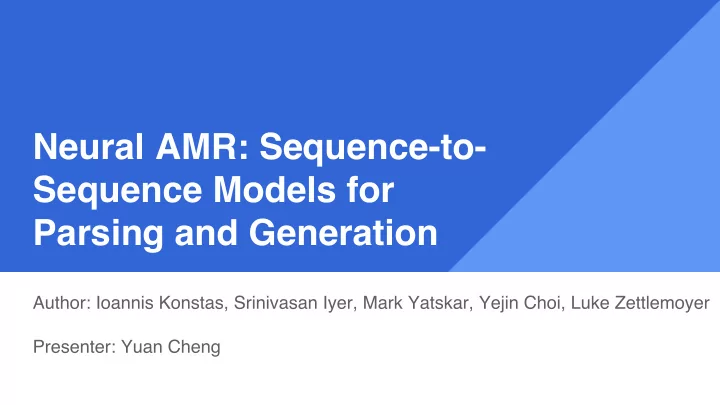

Neural AMR: Sequence-to- Sequence Models for Parsing and Generation Author: Ioannis Konstas, Srinivasan Iyer, Mark Yatskar, Yejin Choi, Luke Zettlemoyer Presenter: Yuan Cheng
Contents • Background • Outline of the Paper • Sequence-to-sequence Model • Abstract Meaning Representation • Key Takeaways
What is AMR AMR – Abstract Meaning Representation A method to define “Who did what to whom?” Forms: Conjunctions of logical triples Rooted, labeled, directed, graph
1. Variables (graph nodes) for AMR - Example entities, events, and states. 2. Each node in the graph represents a semantic concept. 3. Concepts can either be English words (prince), PropBank framesets (say-01),or special keywords
AMR – Example
Seq2seq Model Sequence-to-sequence learning (Seq2Seq) is about training models to convert sequences from one domain to sequences in another domain, by constructing an encoder and decoder.
Method Outline - Tasks With a pair of natural sentence s, and AMR a, train an AMR parser to predict AMR a for sentence s, and a AMR generator to predict sentence s with AMR a.
Method Outline – Seq2seq Model • Stacked bidirectional-LSTM Encoder and Decoder • Encode an input sequence and to decode from the hidden states produced by the encoder. • Concatenate the forward and backward hidden states at every level of the stack instead of at the top of the stack. • Introduce dropout in the first layer of the encoder
Method Outline - Pair Training 1. Input: Training set of sentences and associated AMR graphs 2. Output: AMR parser and AMR generator 3. Self-training: (1) parse samples from a large, unlabeled corpus, (2) create a new set of parameters by training on the previous iteration, and (3) tuning parameters. AMR Parser 4. Use Parser to label AMRs for corpus
Method Outline - Pair Training 1. Generated expensive AMR associated corpus 2. Increased the sample size for Seq2Seq Model 3. Reduced Sparsity
Method Outline – AMR Preparation 1. Graph Simplization 2. Dates Anonymization 3. Name Entity Clustering
Methods Outline – AMR Preparation 1. Graph Simplization 2. Dates Anonymization 3. Name Entity Clustering
Methods Outline – AMR Preparation 1. Reduced complexity 2. Addressed open domain vocabulary entries, such as named entities.
Key Takeaways 1. 1. A novel approach of using Seq2seq model on AMR decoding and encoding though details to be dicussed. 2. 2. Reduced Sparsity by paired training 3. 3. Open-domain capability for unlabeled dataset
Thank You
Recommend
More recommend